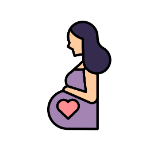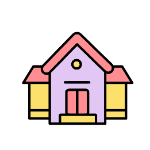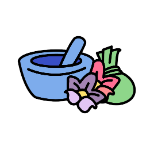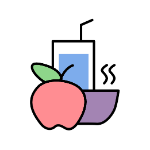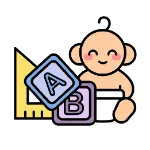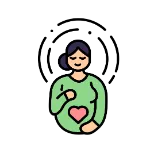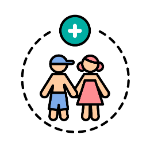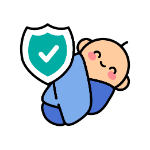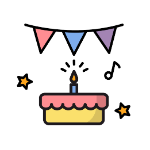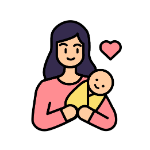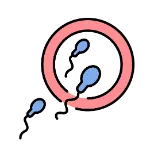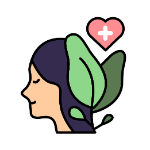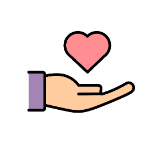
Newborn Wellness
How To Take Care Of Your Newborn's Umbilical Cord
7 min | Updated on 28-01-2022 by HappyPreggie
You'll want to know about umbilical cord care as a parent of a newborn, including how to keep your baby's umbilical cord stump dry until it falls off, how to detect indications of infection, and when to contact your healthcare practitioner.

(Image credits to Canva)
The umbilical cord stump of your newborn is a funny little piece of skin that serves as the final link to his/her time in the womb. When your baby's umbilical cord is cut at birth, a portion of it stays linked to the navel, and it will undergo a transformation during his/her early days. Read the whole article to know more about how to take care of your newborn’s umbilical cord.
Your baby in the uterus received nourishment and oxygen through the umbilical cord. The cord is clamped and severed shortly after your baby is born. Because the umbilical cord lacks nerves, your newborn will be unharmed.

(Image credits to Canva)
Typically, the clamp is left in place for 24 to 48 hours. Once the remaining chord has dried and no longer bleeds, it is removed. The only thing left on your baby's belly once the clamp is removed is a small stump. The umbilical cord stump will change color from yellow to brownish-black as it dries, shrivels, and hardens.
Within a few weeks of your baby's birth, the umbilical cord stump normally falls off. If it hasn't dropped off by the time your baby is two months old, contact your child's healthcare provider. Your physician will evaluate whether there is an underlying explanation for the umbilical cord stump not dropping off, such as an infection or an immune system disorder.
The skin beneath the stump should recover once the stump falls out. The skin may be a bit raw at times, and a small amount of fluid may flow out. Keep your child's belly button dry and clean, and it should recover entirely in no time. If it hasn't healed within two weeks of the stump falling off, contact your healthcare professional.
When it comes to caring for a newborn umbilical cord, it is now normal practice to keep it dry. To promote healthy healing, avoid rubbing alcohol and other ointments and instead follow these tips to care for the umbilical cord:
If the stump becomes dirty, wipe it lightly with a wet washcloth before patting it dry. This is unlikely to be necessary, as the cord is normally kept clean. Soap should be avoided since it can irritate a baby's sensitive skin.

(Image credits to Canva)
"Dry cord care," according to experts, means letting air reach the cord stump rather than covering it with water or ointments. Although you may have heard of dabbing rubbing alcohol on the stump, specialists now advise simply leaving it alone. If you're not sure what to do, seek guidance from your healthcare professional.
Fold the top of the diaper down beneath the cord stump or use a disposable diaper with a cutout notch at the top to keep your newborn's diapers from rubbing against the stump.
For the time being, don't dunk your baby's navel underwater — sponge baths will be sufficient. Bathe your kid in his pint-sized tub once the stump has fallen off.

(Image credits to Canva)
Wet and dirty diapers should be changed as soon as possible so that they don't flow upward toward the navel area and irritate your baby's healing cord.
Choose clothing with a particular cutout for this area or loose-fitting clothing that doesn't press against the stump. Try kimono-style bodysuits, which tie on the side for increased air circulation and less irritation, instead of onesies that snap at the crotch.
Allow the scab to fall off naturally. Never pull it, even if it just appears to be connected by a fragment of a thread. It may start bleeding continually if it is ripped off too soon. If this occurs, contact your baby's doctor right away.
Although it's rare that your baby's umbilical cord stump will become infected, contact your baby's healthcare practitioner if you see any of these indicators of an infected umbilical cord. These are some of the signs of an infected umbilical cord:
Following the cord's extraction, you may observe a reddish moist lump or nodule around the cord's removal area that becomes somewhat larger and continues to ooze. If it doesn't go away after a week or so, your baby's healthcare professional may have to remove it.
When your baby cries, his belly button bulges out, which could indicate an umbilical hernia. This is a small opening in the abdomen wall that allows tissue to protrude out when pressure is applied, such as when your baby cries. When your child is between the ages of 12 and 18, an umbilical hernia will usually heal.
What's left of the umbilical cord will fall off a few weeks after your baby is born, revealing your baby's adorable little belly button. It serves as a reminder of how far your child has progressed in such a short period of time. If you found this article helpful share it with other mommies to let them know as well.
At HappyPreggie you will get tons of amazing blogs which will help you guide your motherhood journey. If you want to read more of our contents, you can try reading- Best Lotions For Soft Baby Skin In Malaysia or you can also read- Top 10 Diapers In Malaysia To Keep Your Baby Dry.
(Image credits to Canva)
The umbilical cord stump of your newborn is a funny little piece of skin that serves as the final link to his/her time in the womb. When your baby's umbilical cord is cut at birth, a portion of it stays linked to the navel, and it will undergo a transformation during his/her early days. Read the whole article to know more about how to take care of your newborn’s umbilical cord.
When does the umbilical cord fall off?
Your baby in the uterus received nourishment and oxygen through the umbilical cord. The cord is clamped and severed shortly after your baby is born. Because the umbilical cord lacks nerves, your newborn will be unharmed.
(Image credits to Canva)
Typically, the clamp is left in place for 24 to 48 hours. Once the remaining chord has dried and no longer bleeds, it is removed. The only thing left on your baby's belly once the clamp is removed is a small stump. The umbilical cord stump will change color from yellow to brownish-black as it dries, shrivels, and hardens.
Within a few weeks of your baby's birth, the umbilical cord stump normally falls off. If it hasn't dropped off by the time your baby is two months old, contact your child's healthcare provider. Your physician will evaluate whether there is an underlying explanation for the umbilical cord stump not dropping off, such as an infection or an immune system disorder.
The skin beneath the stump should recover once the stump falls out. The skin may be a bit raw at times, and a small amount of fluid may flow out. Keep your child's belly button dry and clean, and it should recover entirely in no time. If it hasn't healed within two weeks of the stump falling off, contact your healthcare professional.
How to Care for and Clean the Umbilical Cord Stump
When it comes to caring for a newborn umbilical cord, it is now normal practice to keep it dry. To promote healthy healing, avoid rubbing alcohol and other ointments and instead follow these tips to care for the umbilical cord:
#1 Keep it clean
If the stump becomes dirty, wipe it lightly with a wet washcloth before patting it dry. This is unlikely to be necessary, as the cord is normally kept clean. Soap should be avoided since it can irritate a baby's sensitive skin.
(Image credits to Canva)
"Dry cord care," according to experts, means letting air reach the cord stump rather than covering it with water or ointments. Although you may have heard of dabbing rubbing alcohol on the stump, specialists now advise simply leaving it alone. If you're not sure what to do, seek guidance from your healthcare professional.
#2 Prevent Irritation
Fold the top of the diaper down beneath the cord stump or use a disposable diaper with a cutout notch at the top to keep your newborn's diapers from rubbing against the stump.
#3 Stick To Sponge Baths
For the time being, don't dunk your baby's navel underwater — sponge baths will be sufficient. Bathe your kid in his pint-sized tub once the stump has fallen off.
#4 Change Diapers Frequently
(Image credits to Canva)
Wet and dirty diapers should be changed as soon as possible so that they don't flow upward toward the navel area and irritate your baby's healing cord.
#5 Dress Delicately Too
Choose clothing with a particular cutout for this area or loose-fitting clothing that doesn't press against the stump. Try kimono-style bodysuits, which tie on the side for increased air circulation and less irritation, instead of onesies that snap at the crotch.
#6 Check for signs of infection
Clear liquid oozing from the stump, blood drops, and scabbing are all common, but if you observe any signs of an infected umbilical cord stump, or if your child has a fever, contact your healthcare professional straight away.#7 Resist Touching Or Pulling
Allow the scab to fall off naturally. Never pull it, even if it just appears to be connected by a fragment of a thread. It may start bleeding continually if it is ripped off too soon. If this occurs, contact your baby's doctor right away.
Infected Umbilical Cord Stump Symptoms
Although it's rare that your baby's umbilical cord stump will become infected, contact your baby's healthcare practitioner if you see any of these indicators of an infected umbilical cord. These are some of the signs of an infected umbilical cord:
- A foul-smelling yellow discharge comes from the stump.
- The skin around the stump becomes reddish.
- Swelling of the navel area.
- Your baby cries when you touch the stump, indicating it is tender or sore.
- Fever or lethargy.
- Low appetite
- A fluid-filled bump on or near the umbilical cord stump of your newborn.
Umbilical Cord Conditions
These are two diseases that affect the umbilical cord or the navel area. If you suspect your newborn has one or both of these conditions, talk to your doctor.#1 Umbilical Granuloma
Following the cord's extraction, you may observe a reddish moist lump or nodule around the cord's removal area that becomes somewhat larger and continues to ooze. If it doesn't go away after a week or so, your baby's healthcare professional may have to remove it.
#2 Umbilical Hernia
When your baby cries, his belly button bulges out, which could indicate an umbilical hernia. This is a small opening in the abdomen wall that allows tissue to protrude out when pressure is applied, such as when your baby cries. When your child is between the ages of 12 and 18, an umbilical hernia will usually heal.
What's left of the umbilical cord will fall off a few weeks after your baby is born, revealing your baby's adorable little belly button. It serves as a reminder of how far your child has progressed in such a short period of time. If you found this article helpful share it with other mommies to let them know as well.
At HappyPreggie you will get tons of amazing blogs which will help you guide your motherhood journey. If you want to read more of our contents, you can try reading- Best Lotions For Soft Baby Skin In Malaysia or you can also read- Top 10 Diapers In Malaysia To Keep Your Baby Dry.
Join the largest support network for family health and well-being. Ready to get started?
Get started
